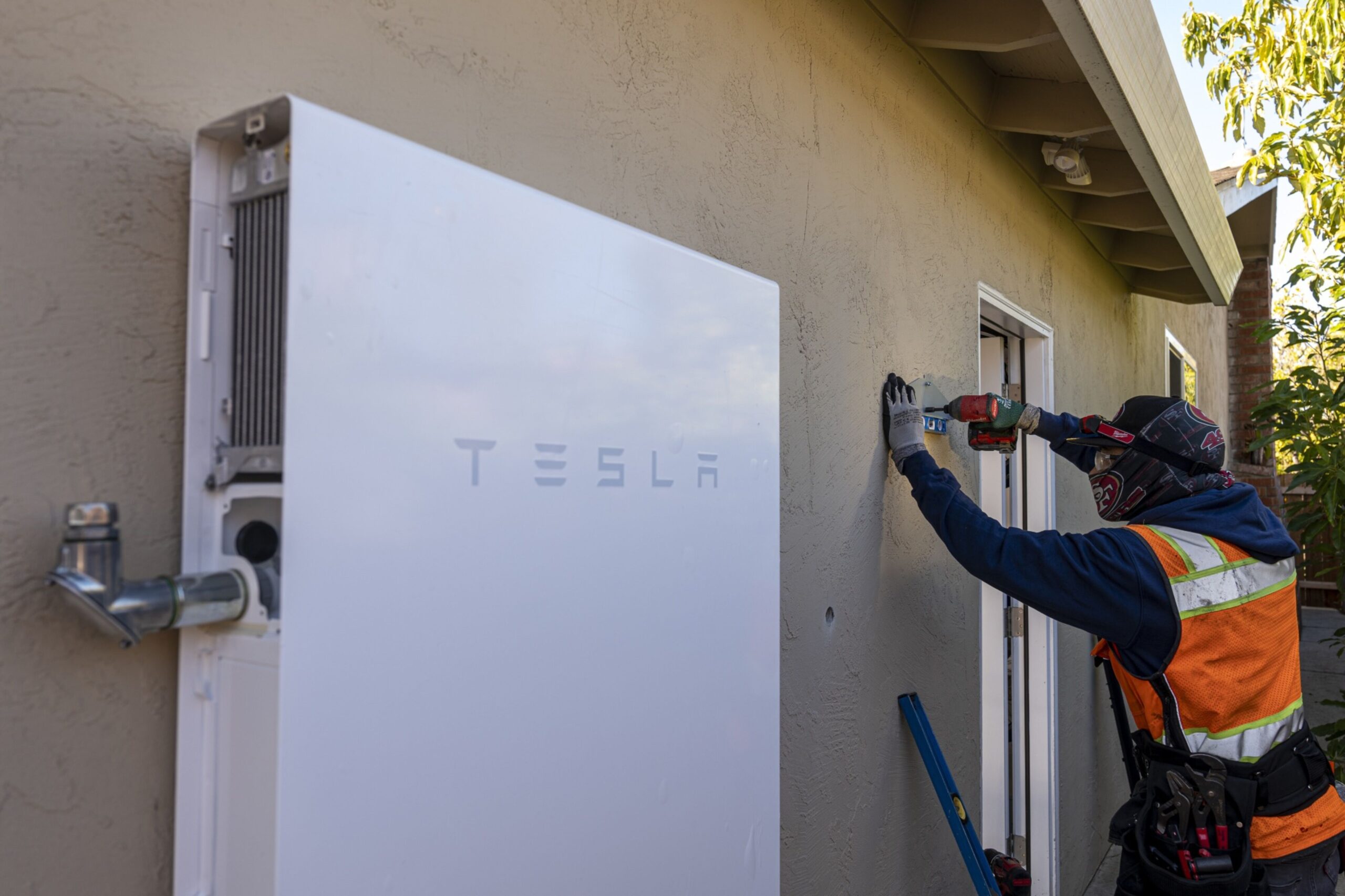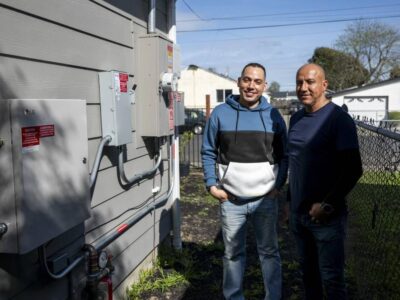(Bloomberg) —
Residential solar and energy-storage systems are fast becoming a popular way to lower your carbon footprint, offset rising electricity prices and keep the lights on during more frequent climate-related power outages. On Monday, nearly half a million Californians remained without power as severe storms struck the state.
Electricity generated by rooftop solar panels can be stored in lithium-ion or lithium-iron-phosphate batteries — the two most popular types of home-energy storage — so that it can be used at night when utility rates often spike. BloombergNEF estimates the amount of energy stored in residential and commercial batteries will jump 40% this year, and many countries provide generous incentives to encourage installation of home battery systems.
In the US, both state and federal policies help defray the upfront costs. Those incentives, coupled with concerns about blackouts and energy prices, are also driving owners of existing rooftop solar systems to add battery storage to the mix. In 2022, almost a quarter of residential battery installations in the US were such retrofits, according to a Lawrence Berkeley National Laboratory report.
In other words: If you’re thinking of going solar, you should get up to speed on batteries.
Why you need a home battery
Putting solar panels on your roof may not pay off for many years unless there’s also a battery in your garage. As rooftop solar generates more electricity in states like California, there’s a growing need to store the excess for use at night when demand spikes. Climate change is also exacerbating that imbalance in the power grid. When a heat wave hits or the skies turn smoky from wildfires, everyone turns on their air conditioners at once; tapping electricity stored in batteries can help prevent blackouts.
To push homeowners to include battery storage with a new solar system, California regulators last year slashed the value of the credits earned for supplying electricity to the grid by 75%. They’ve also jacked up utility rates at night to encourage people to, for example, charge their EV during the day when cheaper renewable energy is plentiful. Batteries circumvent both of these challenges: Consumers can store excess electricity generated by a solar array to power their homes in the evening, when rates are higher, rather than selling it to the local utility for peanuts.
Hawaii is one state that has doubled down on energy storage. In 2022, a staggering 96% of homeowners who bought rooftop solar systems also installed batteries as a result of state policies, according to the Lawrence Berkeley report. Across the US, the battery adoption rate was 10% that year.
Other countries are also jumping on the battery bandwagon. In Australia, for instance, spiking utility rates and the availability of subsidies helped double the percentage of households that included batteries with new solar systems between 2021 and 2022, according to BloombergNEF. About 75% of new home-solar systems in Germany were integrated with a battery in 2022. Italy is another hotspot, with a battery adoption rate of 77% in 2022, up from 11% in 2018 thanks to lucrative incentives.
If optimizing energy use isn’t compelling, there’s also the in-case-of-emergency argument. Many homeowners have learned the hard way that if the grid goes down during a wildfire, hurricane or heat wave, your solar system won’t keep the lights on unless it’s connected to a battery.
How much a home battery costs
They’re not cheap. A mid-size 13-kilowatt-hour battery retails for an average of $14,187 in California, according to a survey conducted by EnergySage, a Boston-based company that operates an online solar-and-storage marketplace for consumers.
A 30% federal Inflation Reduction Act tax credit for home batteries softens that blow, and some states and utilities offer additional incentives and rebates. California officials estimate a nine-year payback period for residential solar and battery systems.
Factors to consider when buying a home battery
The first thing you need to do is make sure you select a battery with a capacity that’s suitable for the size of your rooftop solar system.
“You need to have a battery that’s big enough to store all your excess solar energy,” says Nelson Nsitem, an analyst at BloombergNEF who covers the energy storage industry. “If you install a battery that’s too small, then you’re not able to store that excess. But if it’s too big, you’re paying too much.”
Something else to consider is whether a battery system is “stackable,” meaning you can add additional units as your electricity demand grows. You may initially need a battery big enough to power a heat pump and induction stove, for example, but aim to add an EV charger and a heat pump water heater in a few years. However, if your main reason for buying energy storage is to keep the electrons flowing during a blackout, then you’ll need a bigger battery or multiple batteries if you want to power most of your appliances.
Spencer Fields, EnergySage’s director of insights, says that before you start comparing the technical specifications of particular brands, check out the warranty. “You want to know that in the event that something goes wrong with the battery, you’re covered by a very strong, robust warranty,” he says.
Many battery warranties are for 10 years, though some companies cover their products for 12 or 15 years. A key provision to look out for is whether the warranty only covers a certain number of times a battery can cycle through charging and discharging. Some brands, for example, limit coverage to 6,000, 8,000 or 10,000 cycles.
Should I go with the battery offered by my solar installer?
If you’re buying a new home-solar system, you’ll likely get a battery offered by your installer. (Sunrun, one of the largest solar installers in the US, said in November that more than 85% of its California customers opted for batteries in the third quarter.) Some solar installers make batteries themselves, while others have a brand of choice. Either way, you should first check whether the two technologies can be installed at the same time, or if you should expect any delay between the installations.
When evaluating a battery brand, remember that name recognition isn’t a prerequisite for quality. You’ve probably never heard of most battery brands, and Nsitem says home batteries are becoming commodities much like solar panels. What is key is the software that controls power management and ensures the battery is storing and discharging electricity at optimal times, particularly in states like California that have complex rate structures.
To evaluate that system, take a look at its mobile app to see how much information is shared, and how clearly. “Those things are important as you may be missing out on the ability to monitor and manage your consumption in an efficient way,” Nsitem says.
You’ll also want to ask if the software would allow your battery to be integrated into a virtual power plant, which aggregates batteries in a particular area so utilities or grid operators can better balance demand and electricity supply. In exchange for letting the utility control their batteries at certain times, homeowners receive a payment. Sunrun, for instance, signed a deal last year with California utility PG&E Corp. to enroll 7,500 customers into a virtual power plant to help avoid blackouts during heat waves.
What to ask a solar installer about their batteries
Fields recommends querying a prospective solar installer about why they’ve chosen a particular brand to make sure the characteristics of the battery system align with your needs. For instance, a solar company may favor one battery for its lower cost of installation and operation, or another brand because it’s easy to add additional storage. If keeping costs down or future-proofing a solar and storage system are important, then that installer may be right for you.
To contact the author of this story:
Todd Woody in San Francisco at twoody4@bloomberg.net
© 2024 Bloomberg L.P.





